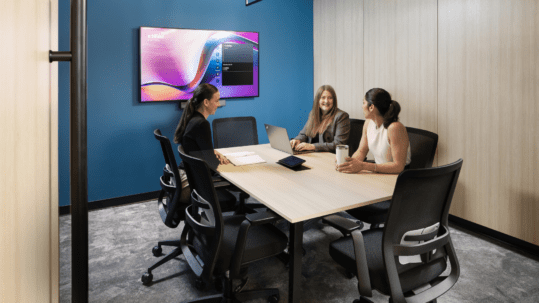How to effectively and efficiently plan for a commercial lease expiry.
Critical Considerations for a Commercial Lease Expiry
Plan Ahead
Renegotiating, terminating, or extending a commercial lease takes time and effort and should not be left to the last minute. When organizations are unaware of how long it takes to find a suitable space, it can lead to irritation and missed opportunities. In a competitive market, having more time provides you with more options. When a lease expiry is approached strategically and planned with sufficient time, tenants can conduct better market research, have greater negotiation power, and are able to decide their next move strategically.
A timeframe for planning for a lease expiration must consider various factors. Some factors to consider are company size, how your employees work, and predicted future growth. Furthermore, the bigger the organization, the more time is required, especially if continuous floors within one building are needed. We recommend starting within the time frames listed below:

Adhering to these timeline suggestions will allow tenants to investigate the market, plan for negotiations, and ensure all possible opportunities are considered. Furthermore, with the advent of hybrid and remote work, square footage requirements are more ambiguous than ever. As a result, the more time you plan ahead of a commercial lease expiry, the more equipped you are to make informed decisions.
Consult with a Workplace Strategist
Approaching the end of a lease can raise several questions regarding your current space. Is your existing workspace a suitable size to support the needs of your employees and your business? Will it accommodate projected growth? Knowing what to do next can be challenging to do on your own. The best way to prepare for a lease expiration is to speak with a professional who can help you determine your office space requirements and advise you on the next steps. Designing a supportive workplace can be difficult without a structured idea of how your employees work best. A workplace strategist can help you with your workplace needs by measuring and analyzing workplace effectiveness through discussion, site observation, space utilization, and benchmarking studies. Furthermore, they can identify workstyle personas and how they can be supported by the built environment, employee and space barriers to productivity and overall attitude toward change. Working with a professional to develop a strong workplace strategy can also help optimize space utilization and reduce corporate real estate costs.
Base Decisions on Data
Space and real estate decisions are becoming exceedingly challenging with the rise of distributed work facilitated by hybrid and remote working models. Previously, decision-makers could make real estate decisions based on the number of employees and the recommended square footage needs per employee. However, establishing how much office space is needed is difficult to calculate when office occupancy rates vary daily. When a company is confused about its space requirements, selecting whether to renegotiate, terminate, or extend a lease becomes increasingly difficult. Data provides businesses with a more granular level of information, allowing them to gain more specific insights to help them plan for the future.
Pivvot Strategy

At Aura, we partner with Pivvot Strategy, a software solution designed to help companies future-proof their workplaces by assisting them in making informed, data-based decisions. Pivvot’s workstyle personas are created from leadership alignment and employee assessments, informing three dashboards that help influence work style, space allocation, and economic choices.
Work style persona: Information gathered from a company-wide assessment provides information about employees’ workspace needs and desires. This helps companies develop a remote work policy. It also displays productivity scorecards for individual employees, highlighting areas for improvement.
Space calculation: Shows the square footage needed per persona. The dashboard helps visualize the amount of space each employee will require for collaboration, focus and social interactions.
Work style impact: Indicates the financial, social, economic, and environmental impact of your decisions on your organization and the community.
Our partnership with Pivvot aims to assist businesses in making data-driven and informed decisions. At Aura, we understand that many business leaders need help determining the types of space required, dealing with hybrid workers, and office space allocation, all of which impact real estate decisions. Companies that use data to back up real estate considerations can make more educated, people-centric decisions.
Steps for a Successful Transition
An upcoming lease expiry allows businesses to review their current position as a tenant, revisit the commercial real estate market, and use that information to negotiate a better lease agreement. Here are some essential steps to ensure a smooth lease expiry changeover and that all options are explored when considering a future renovation, build-out, or move.
Assess your Current Space
When a lease expiry is approaching, businesses should evaluate how effectively the current workplace works. Is all the available space being used, or are some areas underutilized? Is your workplace at capacity, with no room for growth? If your company’s spatial needs have changed, consider increasing or decreasing square footage and searching elsewhere. Companies must have an internalized space audit and assess their current space before making significant decisions.
Research the Market
Whether you intend to extend your lease or relocate, market research is vital in the commercial lease expiry process. Educating oneself on the current market may reveal other alternatives that are competitive and worth pursuing, or it may allow you to negotiate a better deal with your existing landlord. Market circumstances and availability, for example, may have changed since you signed your last lease. Alternatively, other landlords may provide better contract terms, less debt, reduced taxes, or more desirable amenities.
When researching the market, remember that no commercial spaces are the same. Consider the following questions to set your company up for success.
- What does the current market look like? What is the average rent?
- Are the market trends comparable to your current lease and rental agreement?
- Are there any desirable vacancies in your area? Is your current neighbourhood working? Have you considered the possibility of moving?
- Is a new commercial development an option for your organization?
Prepare for Negotiations
Once you have assessed your current space and done market research, the next step is negotiating with your current landlord to discuss new contract ideas. Refrain from accepting all the landlords’ terms and conditions. It’s within your rights as an independent business to negotiate the financial terms of your lease, so come to the table ready to negotiate. In any negotiating session, an organized and researched strategy is required. Gather all current lease and rental documentation and any paperwork related to your present building. Examining this data can help you get a clear picture of your current condition and whether there is an opportunity for development.
This documentation should include the following:
- A current lease contract and rental specifics
- Financial documentation (including operating costs)
- Building info
- Potential renovation or reconfiguration budgets
- Projected organizational growth forecasts.
Decision time: Renew and Renovate or Move
Renew
If you are satisfied with your current office and location, you can opt to renew your lease. Renewing a lease, however, does not mean you cannot update your workplace to meet your labour pool’s demands better. At Aura, we can help reimagine your workplace to represent your company culture better. Creatively reimagining how to utilize your current space better can similarly usher in a renewed sense of productivity, creativity, and freshness for your office environment.
Move
If you foresee significant growth within the next year or so that may leave you with a tight and unproductive workspace, it may be worthwhile to consider moving. Aside from growth, relocation may provide new working styles and approaches that promote efficiency and creativity within your firm. A new environment can cause you to reconsider how you work, and that mental shift can help you build a stronger, more sustainable brand. Relocation may also be more appealing if there is space for financial savings and a more attractive leasing agreement elsewhere.
Planning for the end of an office lease can be complicated and perplexing. However, if enough time is set aside, data is utilized, market research is undertaken, and a workplace strategist is consulted, the transition can go seamlessly. Whatever your firm decides, your office atmosphere must foster genuine sentiments of connection and ownership. It is not always about the bottom line; it’s about how well your workplace fits the way your team works together, how it stimulates creativity and cooperation, and what kind of space you can envision helping your company grow together.
Talk with a Workplace Expert Today
Whether your lease is up in 6 months or three years, it is critical to plan to ensure a seamless and streamlined transition. Contact Us to see how we can help with your next commercial design & build project. Our team is here to answer any questions regarding the workplace.






